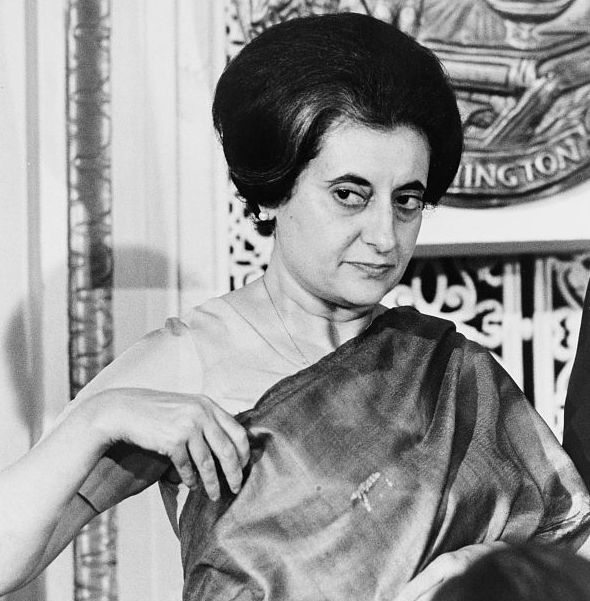Indira Gandhi’s Darshan
An Intimate Portrait of the Late Prime Minister
In 1966, Indira Gandhi became India's first female Prime Minister, and in doing so, one of the world's most powerful women. She had grown up in a political household, as the daughter of a Prime Minister, and viewed the intricacies of political life from early childhood onwards. Her father, Jawahalal Nehru, had worked alongside Mohandas Gandhi to bring India to independence from the British in 1947.
Indira Gandhi's last four years in office had been challenged by freedom fighters seeking statehood for the historic Sikh homeland of Punjab. It is believed that her assassination was motivated by her decision to have the Indian Army besiege a large Sikh worship site in order to kill a leader in the freedom fighter ranks.
A November 11, 1985 Time Magazine piece summed up the mixed legacy of her leadership: "Two divergent sentiments, grief and joy, were voiced last week as Indians marked the first anniversary of the assassination of Prime Minister Indira Gandhi ... In New Delhi there was sadness as an estimated 500,000 people gathered ... but in Amritsar, Punjab, there was gladness as Sikh militants celebrated Mrs. Gandhi's death."
The following excerpt is from an article by Joy Billington, originally published in The Saturday Evening Post, right before the State of Emergency. It provides a rare, intimate portrait of Indira Gandhi's leadership style.
Next door to Number One Safdarjang Road is another low, thick-walled white bungalow. The gardens of the two houses are adjoined. It is just after eight o'clock one September morning. The gate between Number One, the second house on the block, and this corner garden, is still closed. On the lawns, several groups of men and women are seated on carpets near the path. In the "receiving" bungalows, kept exclusively for this purpose, other groups of individuals wait. Another day, anotherdarshan (a kind of audience or receiving of petitioners) is beginning for the Prime Minister of India.
As the green gate between the two gardens swings open, the small figure wrapped in the yellow hand-loomed sari seems almost Biblical. Seen from closer up, the short dark hair with its broad streak of white rising from the center of the widow's peak and the dominant nose seem more suggestive of a Roman senator. But as she discards the large black umbrella protecting her skin from the sun and moves to greet a village delegation, making the Indian "Namaste" greeting, she is Indira Gandhi, the person called the "most powerful woman in the world" who has come to personify nuclear-age India to the rest of the puzzled world.
The darshan, to which any person can come, is held most mornings of the week. This morning, for about an hour and a half, she listens to problems ranging from sacred cows to police brutality...She is straight backed and reserved, as she walks back from the darshan into her own garden.
She does not carry a handbag, or wear makeup. In all the thousands of photographs of this woman...whether from the rear, with her sari wrapped over her head, speaking to a crowd of thousands...or toughly preoccupied in a political caucus ... she combines both severity and austerity. In fact the coarse woven khadi cloth sari suits her particular handsomeness fare more than the softness of silk.
Indira Nehru was born in 1917, in the family house "Anand Bhavan" (House of Joy) in Allahabad. ... By 1917, the forces of history were changing. ... Jawahalal was a follower of Mahatma Gandhi, active in the independence movement. ... In the years that followed, her father spent a total of ten years in jail, imprisoned by the British. Kamala (her mother), too, frequently had to go to jail, and her frailty brought on tuberculosis. Indira, born in the year of the Russian Revolution, was a lonely child. ... As a child, Indira did not have a British governess... Thus the Westernization process was avoided, her Hindi idiom fostered, and she grew up thinking like an Indian.
The insecurity of those days was increased by regular police raids and the confiscation of the family's goods, which infuriated Indira. At the age of five, when the Nehru family was making a symbolic bonfire of British-made goods, someone told her that her doll was British-made. After days of thinking it over, she made her own bonfire and burned her beloved doll.
When Betty Friedan asked her to pinpoint the particular moment in her life when she was drawn into politics in her own right, Mrs. Gandhi recalled standing in for her father in a campaign speech for a woman candidate. She found that people listened to her.
She says when she first became Prime Minister, she had no doubts about what she had to offer. "It's difficult to put into words, but when one's standards are very high...Once you accepted the job there was no time to think whether you could or couldn't. You just had to get on with it."
This woman, leader of the world's largest democracy, admired by a vast majority of India's 550 million citizens, disliked by many of the middle class, is never criticized because of her sex. There are no off-color jokes in the bazaars about her, a diplomat says: "She exemplifies the fact that sex has nothing to do with power in politics." Indian women won their colors in the fight for independence, Mrs. Gandhi says, but "on the whole, even in the past, women have not felt suppressed. They have been. But a person who wanted to could usually break through, though, not always. ... I've never had that feeling because nobody ever stopped me from doing anything."
Reprinted from The Saturday Evening Post magazine, ©1975 Saturday Evening Post Society. Reprinted with permission www.saturdayeveningpost.com.


